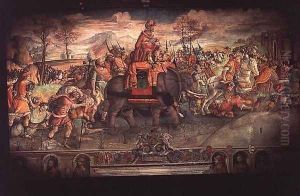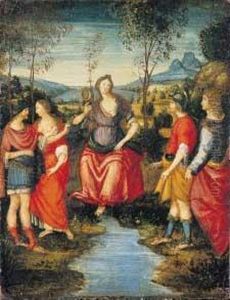Jacopo Ripanda Paintings
Jacopo Ripanda was an Italian painter and draftsman, active during the late 15th and early 16th centuries, a period known for the High Renaissance. Little is known about Ripanda's early life, including the exact date and place of his birth, which is estimated to have been in the 1460s, based on the stylistic analysis of his work and the few historical records available.
Ripanda's career is better documented from the late 1490s onwards when he started receiving commissions in his native Bologna. He is known to have been significantly influenced by the Bolognese school, which itself was under the strong influence of the Florentine Renaissance, thanks to artists like Lorenzo Costa and Francesco Francia who were active in the city during that time. Ripanda was also contemporary with other prominent artists such as Raphael and Michelangelo, who were transforming the artistic landscape of Italy.
One of Ripanda's most famous works is a series of frescoes depicting scenes from ancient Rome, which he painted for the Palazzo della Cancelleria in Rome. These works demonstrate his interest in classical antiquity, a characteristic of Renaissance humanism. His style in these frescoes is noted for its dynamic compositions and attention to architectural details, which show a clear understanding of perspective, a hallmark of Renaissance art.
Ripanda's death is as obscure as his birth, with no precise records to confirm the date. However, it is generally believed that he continued working at least until 1522, as there are records of his artistic activity in that year. The lack of comprehensive documentation has made it difficult for art historians to trace his life in detail, and as a result, he remains a somewhat enigmatic figure in the history of Italian Renaissance art.
Despite the scarcity of biographical details, Ripanda's surviving works contribute to our understanding of the period's artistic endeavors and the diffusion of Renaissance ideals beyond Florence and Rome to other Italian city-states like Bologna. His work is also significant for providing insights into the cultural and historical interests of his patrons, reflecting the broader intellectual currents of his time.

